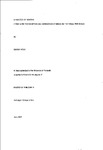A practice of painting : living with the reception and generation of image on the visual threshold
| dc.contributor.author | Fryer, Gladin | |
| dc.contributor.other | Faculty of Arts, Humanities and Business | en_US |
| dc.date.accessioned | 2013-10-25T11:12:55Z | |
| dc.date.available | 2013-10-25T11:12:55Z | |
| dc.date.issued | 2007 | |
| dc.identifier | NOT AVAILABLE | en_US |
| dc.identifier.uri | http://hdl.handle.net/10026.1/2378 | |
| dc.description | Merged with duplicate record 10026.1/718 on 13.20.2017 by CS (TIS) | |
| dc.description.abstract |
My work as an artist takes an image on a journey beginning with a photographic source image and ending in a painted image, passing through the remembered, imagined and perceived. It is important for me that the images in my work are encountered physically through the materials constituting the surface of the painting and mentally through the 'language' of images. Each viewer uniquely completes the image's journey of becoming a painting. My paintings explore and realise the materiality of an image through the layering of paint, varnish, pebbles, gravel and found objects. Through the activity of painting these 'textured' images acquire particular material, photographic and ocular traits. The primary concerns of my painting practice are how the 'material image' arrests and textures our sensations, the reading of images and the implications of those experiences for ourselves, as receptors, repositories and generators of images. An exhibition of paintings with the above title constitutes the findings of this practice driven research, which together with the definitions and critical reflections contained in this accompanying text, form my PhD thesis. The first stage of making a painting is to identify one's materials. The materials I have chosen to use in this text, which explores, defines and locates my 5 year enquiry into a practice of painting, are: my practical research itself (my paintings); the work and voices of other painters working in a similar field; three primary and many secondary texts. The three primary texts I used were: Eye and Mind, by Maurice Merleau-Ponty (Merleau-Ponty M in Johnson, A. G. (1993) pp.121-149); Closure, by Hilary Lawson (Lawson, H. 2001); and Francis Bacon: Sensation and Painting, by Giles Deleuze (Deleuze, G. 2003). This text begins with 15 reproductions of the paintings forming the exhibition, followed by a framing statement. The text then describes the evolution of the practical research through the creation of the individual paintings. My practical research under went four stages of development; these are evidenced in the curation of the exhibition and in the structure of this text. During these stages of my practice's development four central themes emerged - image, meaning, material and layering. Finally the text reflects on "A Practice Of Painting" using the four central themes of my practice together with the themes identified in the three primary texts. The voices and images of the painters float alongside the body of the text as an illustration of the visual dialogue between my own work and theirs. The text closes with a final reflection and appendices containing my own surveys of the three primary texts. My painting practice is primarily concerned with the different modes of image reception and generation. ''It is a very, very close and difficult thing to know why some paint comes across directly onto the nervous system and other paint tells you the story in a long diatribe through the brain. "(Bacon in Deleuze, G. (2003), p.35) | en_US |
| dc.description.sponsorship | Dartington College of Arts | |
| dc.language.iso | en | en_US |
| dc.publisher | University of Plymouth | en_US |
| dc.title | A practice of painting : living with the reception and generation of image on the visual threshold | en_US |
| dc.type | Thesis | |
| dc.identifier.doi | http://dx.doi.org/10.24382/4992 |
Files in this item
This item appears in the following Collection(s)
-
01 Research Theses Main Collection
Research Theses Main


